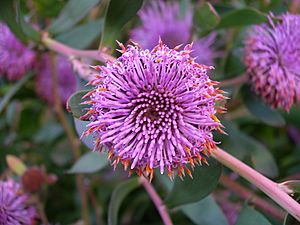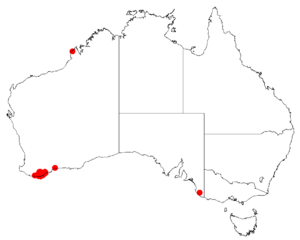Coneflower facts for kids
Quick facts for kids Coneflower |
|
|---|---|
 |
|
| Scientific classification | |
| Genus: |
Isopogon
|
| Species: |
cuneatus
|
 |
|
| Occurrence data from Australasian Virtual Herbarium | |
| Synonyms | |
|
|
Isopogon cuneatus, often called the coneflower, is a special type of plant found only in the south-west part of Western Australia. It's a shrub that has unique leaves and pretty pale to purplish pink flowers. These flowers grow in round, flat heads. It belongs to the Proteaceae family, which includes many other interesting plants.
What Does the Coneflower Look Like?
The coneflower is a shrub that usually grows to be about 1.5–2.5 m (4 ft 11 in – 8 ft 2 in) tall. Its branches are covered in fine, pale to reddish-brown hairs.
Its leaves are shaped like a long oval or an egg, but narrower at the bottom. They are typically 40–100 mm (1.6–3.9 in) long and 10–30 mm (0.39–1.18 in) wide.
The flowers are quite noticeable! They grow in flattened, round heads at the ends of the branches. These flower heads are about 40–55 mm (1.6–2.2 in) wide. At their base, they have broad, egg-shaped leaves called bracts.
Each flower is about 25 mm (0.98 in) long and can be pale pink to purplish pink. They are also smooth, meaning they don't have any hairs. Coneflowers bloom from July to October. After flowering, they produce a hairy, oval-shaped fruit called a nut. These nuts are joined together in a cone shape, up to 35 mm (1.4 in) wide.
How the Coneflower Got its Name
The Isopogon cuneatus was first officially described in 1810. A botanist named Robert Brown wrote about it in a scientific paper called the Transactions of the Linnean Society of London. This was how the plant got its scientific name.
Where Does the Coneflower Grow?
The coneflower lives in different types of natural areas in Western Australia. You can find it in heathland (areas with small shrubs), shrubland (areas with many shrubs), and low woodland (forests with smaller trees).
It prefers to grow on stony hills and in swampy flat areas. Its natural home is between the towns of Albany, the Stirling Range, and Cheyne Bay. These areas are part of the Esperance Plains, Jarrah Forest, and Warren regions of Western Australia.


